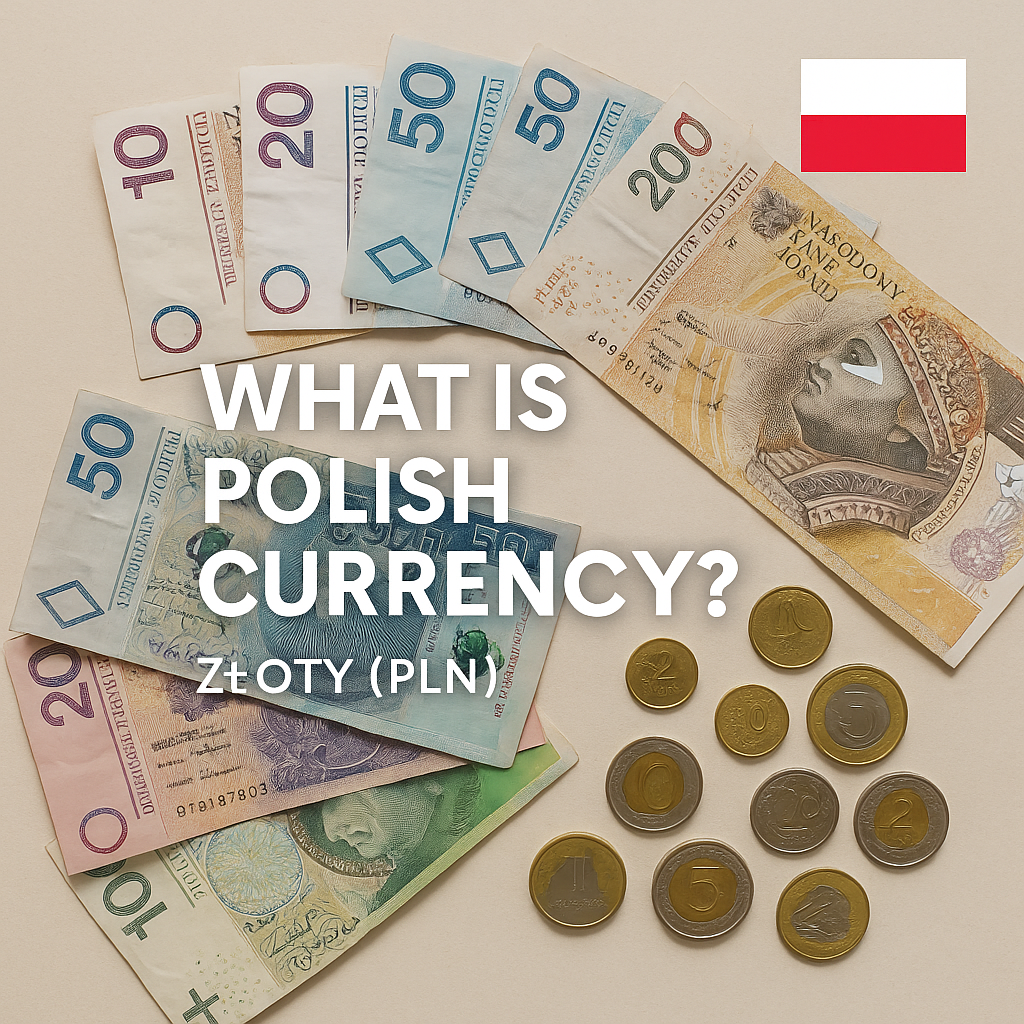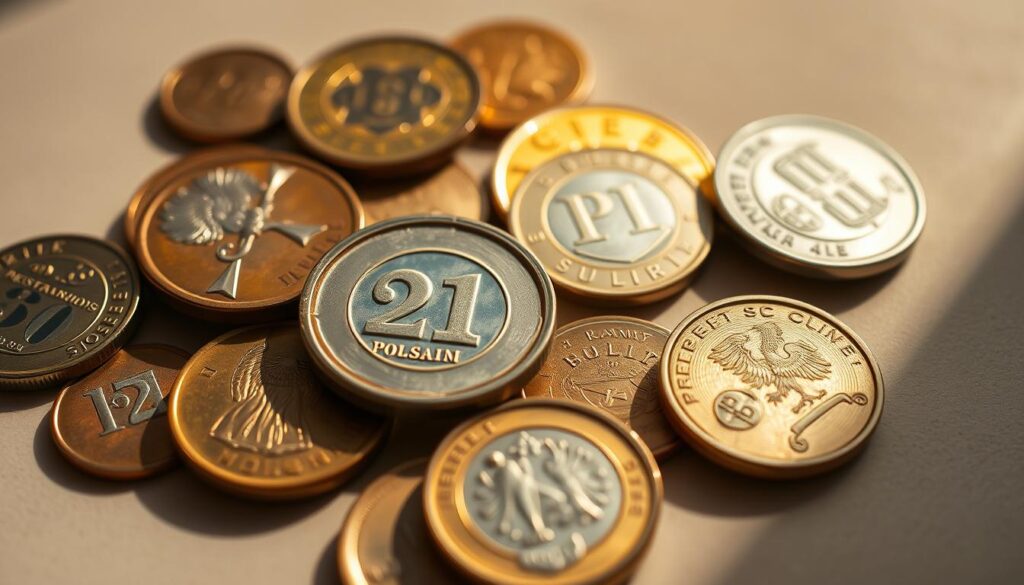
Planning a trip to Poland? Knowing the local currency, the złoty (PLN), is key for a smooth trip. The złoty, symbolized as “zł,” is Poland’s official currency. It’s issued and managed by the Narodowy Bank Polski (NBP).
Travelers should understand the złoty’s role in Poland’s economy. Knowing the current exchange rates is important. It affects how much you can buy during your trip. Whether exchanging money before you go or using ATMs in Poland, knowing the złoty’s value is essential for your budget.
Key Takeaways
- The official currency of Poland is the złoty (PLN).
- The Narodowy Bank Polski (NBP) is responsible for issuing and managing the złoty.
- Understanding the current exchange rates is crucial for travelers.
- Exchange rates can significantly impact your travel budget.
- Knowing the value of the złoty helps in making informed financial decisions during your trip.
What is Polish Currency: Understanding the Złoty
The Polish złoty, or PLN, is Poland’s official currency. It’s important to know about it when traveling or doing business there. Knowing the złoty will make handling money easier.
The Official Currency of Poland
The złoty is Poland’s legal money, split into 100 groszy. Like other currencies, it has smaller units. This makes it easy to handle different amounts.
Coins and banknotes are used in daily life. Coins range from 1 grosz to 5 zloty. Banknotes come in values from 10 zł to 500 zł. This variety helps with making exact payments.
| Denomination Type | Available Denominations |
|---|---|
| Coins | 1 grosz, 2 groszy, 5 groszy, 10 groszy, 20 groszy, 50 groszy, 1 złoty, 2 złote, 5 złotych |
| Banknotes | 10 zł, 20 zł, 50 zł, 100 zł, 200 zł, 500 zł |
The Polish Złoty Symbol and Code
The Polish złoty is shown as “zł” and has the ISO code “PLN.” This symbol is common in pricing and transactions. The ISO code is key for international dealings.
The National Bank of Poland sees the złoty as a sign of Poland’s economic freedom. It’s a vital part of their money policy.
Knowing the Polish currency, its symbol, and code is key for a smooth experience in Poland. It helps with exchanging money, using ATMs, or making card payments. Being familiar with the złoty makes transactions smoother.
A Brief History of Polish Currency
The history of Polish currency is one of resilience and adaptation. The Polish złoty, Poland’s official currency, has a long and complex history. It spans centuries.
Origins of the Złoty
The term “zloty” first appeared in the 14th century. It initially referred to different gold coins. In 1496, the złoty became Poland’s official currency.
The złoty’s value and design changed over time. This was due to trade, political stability, and the availability of precious metals. Knowing about the złoty’s origins helps us understand Poland’s economic history and its role in Europe.
Modern Złoty After World War II
After World War II, Poland saw big economic changes. The złoty was brought back in 1945 to fight hyperinflation. But it wasn’t until 1950 that the currency was really stable thanks to reforms.
The złoty became a sign of Poland’s economic recovery after the war. It was also a symbol of Poland’s move towards socialist economic policies. The currency went through changes, like redenomination, to fight inflation and stabilize the economy.
Currency Reforms and Denomination
The 1995 currency reform was a big event in the złoty’s history. It changed the złoty’s value, making 10,000 old złoty equal 1 new złoty. This reform made money transactions easier and fought hyperinflation.
The złoty has kept changing, with ongoing efforts to keep it stable. These changes reflect Poland’s economic challenges and its push to join the global financial system.
Polish Banknotes: Denominations and Security Features
Traveling to Poland means you’ll need to know about its banknotes. They come in different values and have special security features.
The National Bank of Poland issues these banknotes. They have various denominations. Each note features a famous Polish figure or event.
Current Banknote Series and Designs
Polish banknotes have values from 10 to 500 złoty. Each note highlights a key moment in Polish history.
- 10 złoty: Shows Jan III Sobieski, who saved Vienna from the Ottomans in 1683.
- 20 złoty: Pays tribute to Frederic Chopin, a famous Polish composer.
- 50 złoty: Commemorates Jan Kochanowski, a major Polish writer.
- 100 złoty: Features Marie Curie, the first woman Nobel Prize winner.
- 200 złoty: Honors John Paul II, the Polish Pope.
- 500 złoty: Depicts King Władysław Jagiełło and Grand Duke Vytautas, marking Poland and Lithuania’s union.
Security Features to Verify Authenticity
Polish banknotes have advanced security features to fight counterfeiting. Here’s what to look for:
- Watermark: Shows a portrait or number when light is shone through.
- Security Thread: A thin line that glows when light is applied.
- Microprinting: Tiny text hard to copy, near portraits or numbers.
- Color-Shifting Ink: Changes color when tilted, often on numbers.
| Denomination | Main Feature | Security Features |
|---|---|---|
| 10 złoty | Jan III Sobieski | Watermark, Security Thread |
| 20 złoty | Frederic Chopin | Microprinting, Color-Shifting Ink |
| 50 złoty | Jan Kochanowski | Watermark, Security Thread |
| 100 złoty | Marie Curie | Microprinting, Color-Shifting Ink |
| 200 złoty | John Paul II | Watermark, Security Thread |
| 500 złoty | King Władysław Jagiełło and Grand Duke Vytautas | Microprinting, Color-Shifting Ink |
Knowing these features helps you use Polish banknotes safely and avoid fake money.
Polish Coins: Denominations and Designs
Polish coins are key in the country’s currency. They come in different values and designs. These coins are not just for buying things; they also hold cultural and historical value.
Current Coin Denominations
Polish coins range from 1 grosz to 5 złotych. The Polish Mint (Mennica Polska) makes them. They stand out with their unique designs and security features.
The current denominations include:
- 1 grosz
- 2 grosze
- 5 groszy
- 10 groszy
- 20 groszy
- 50 groszy
- 1 złoty
- 2 złote
- 5 złotych
Each coin has a special design that shows Polish heritage. For example, the 1 grosz coin has an image of the Polish state. Higher coins show Polish symbols and motifs.
Commemorative and Special Edition Coins
Poland also makes commemorative coins for big events and cultural icons. These coins are popular among collectors and numismatics fans.
Some examples of commemorative coins include:
| Year | Commemoration | Denomination |
|---|---|---|
| 2019 | 100th Anniversary of the Polish-Soviet War | 10 złotych |
| 2020 | 75th Anniversary of the end of World War II | 20 złotych |
| 2018 | 100th Anniversary of Independence | 5 złotych |
These coins are more than just money. They help keep Poland’s history and culture alive.

In conclusion, Polish coins are both useful and culturally rich. They come in many values and special editions. Whether you collect them or just like learning about currency, Polish coins are fascinating.
Current Polish Currency Exchange Rates
The Polish złoty’s value changes often. It’s key to know the current exchange rates. Whether you’re going to Poland or investing in złoty, understanding these rates is crucial.
Złoty to USD Exchange Rate: Trends
The złoty to US dollar exchange rate changes due to many economic factors. Recently, the rate has been good for both travelers and investors.
Here’s a quick look at recent exchange rate trends:
| Date | PLN to USD Rate | Change |
|---|---|---|
| 2023-01-01 | 4.50 | – |
| 2023-02-01 | 4.45 | -1.11% |
| 2023-03-01 | 4.40 | -1.12% |
Factors Affecting Exchange Rates
Many things affect the złoty’s exchange rate. These include economic indicators, global events, and money policies. Knowing these can help guess future rate changes.
Economic Indicators: GDP growth, inflation, and job numbers are important for a currency’s strength.
Geopolitical Events: Political stability, trade deals, and conflicts also play a big role in exchange rates.
By keeping up with these factors, you can better predict future exchange rate changes.
Where to Exchange Polish Currency for Travelers
Knowing where to exchange your money for Polish złoty can save you time and money. It’s important to find the best place to do this during your trip.
Currency Exchange Options Before Your Trip
Before you head to Poland, you have a few ways to get złoty. You can go to your bank or a currency exchange office. It’s wise to compare rates to find the best deal. Some banks might offer better rates for their customers, while others might have better rates for certain currencies.
You can also use online currency exchange services. They can be convenient and offer good rates. But, watch out for any extra fees or commissions they might have.

Exchange Services in Poland
In Poland, you’ll find many currency exchange offices, called “kantors,” in airports and tourist areas. These kantors often have good rates, but it’s smart to compare them. Rates can differ a lot.
Be careful of kantors with very good rates but high fees. Always check the rate and any extra fees before you exchange money.
ATMs and Banking Services
Using ATMs is a handy way to get Polish złoty. Most ATMs in Poland accept international cards and have good rates. But, your bank might charge a fee for foreign transactions.
Banking services are also easy to find in Poland. You can get cash or exchange money at a bank. Some banks might give better rates for bigger transactions.
In short, travelers have many ways to exchange their money for Polish złoty, before and during their trip. By understanding these options and comparing rates, you can get the most value from your money.
Tips for Getting the Best Exchange Rates in Poland
To make the most of your money in Poland, learning about the best exchange rates is key. Smart currency exchange can greatly impact your travel budget.
Exploring Poland can be thrilling, but don’t overlook the currency exchange options. Some places, especially in tourist spots, might charge high fees or offer bad rates.
Avoiding Tourist Traps and Commission Fees
Stay away from exchanging money at airports, hotels, or tourist info centers. These places often have high fees and bad rates. Instead, find reputable currency exchange offices or banks.
Comparing rates is important. Use online tools or apps to check exchange rates before you exchange money. This helps you know if you’re getting a good deal.
| Exchange Location | Average Commission Fee | Exchange Rate |
|---|---|---|
| Airport | 5-10% | Less favorable |
| Hotel | 5-15% | Less favorable |
| Reputable Exchange Office | 1-3% | Market rate |
| Bank | 0-2% | Market rate |
Using Currency Conversion Apps and Tools
Today, many currency conversion apps and tools are available. Apps like XE Currency or Google Currency Converter give you the latest rates. They help you decide when and where to exchange your money.
“The best way to get a good exchange rate is to be informed and compare rates across different exchange services.” – Travel Finance Expert
These tools help you avoid bad rates or hidden fees. Also, tell your bank about your travel plans to avoid transaction issues.
By using these tips, you can get the best exchange rates in Poland. This will help stretch your travel budget further.
Using Credit Cards and Digital Payments in Poland
Credit cards and digital payments are getting more popular in Poland. But, cash is still the go-to in many places. Major credit cards like Visa, Mastercard, and American Express are widely accepted in big cities like Warsaw, Krakow, and Gdansk.
Card Acceptance Throughout Poland
In cities, most places accept credit cards. But, in smaller towns or rural areas, cash is often preferred. It’s wise to carry some Polish złoty (PLN) for these situations.
Contactless and Mobile Payment Options
Contactless payments are getting more common in Poland. Many places accept tap-to-pay cards and mobile payments like Apple Pay and Google Pay. This is especially true in big cities, where you’ll see stickers showing contactless payment acceptance.
Using digital payments is convenient. But, some places might charge a small fee for card transactions, especially for small amounts.
When Cash is Still Necessary
Even with credit cards and digital payments, cash is still needed in some cases. Traditional markets and rural areas often prefer cash. Some small shops or local eateries might not accept credit cards.
| Payment Method | Urban Areas | Rural Areas |
|---|---|---|
| Credit Cards | Widely accepted | Limited acceptance |
| Digital Payments | Commonly accepted | Limited acceptance |
| Cash | Accepted everywhere | Preferred method |
Knowing how payments work in Poland helps you manage your money better. This makes your trip smoother and more enjoyable.
Currency Regulations and Restrictions
When you travel to Poland, knowing the rules about money is key. The Polish government has rules to watch how money moves in and out.
Bringing Currency Into Poland
Here’s what you need to know about bringing money into Poland:
- If you carry €10,000 or more (or its equivalent in other currencies), tell the customs.
- You can bring as much Polish Złoty as you want. But, it’s smart to tell them if you have a lot.
The Polish currency code is PLN. The National Bank of Poland, the central bank, oversees it.
Taking Polish Złoty Out of the Country
When you leave Poland, you can take Złoty. Just remember these tips:
- You can take as much Złoty as you want. But, tell them if you have €10,000 or more.
- Try to exchange any Złoty left before you leave. It might be hard to do outside Poland.
Knowing these currency regulations makes your trip smoother. It helps you avoid problems with the authorities.
Understanding these rules is part of getting ready for your trip to Poland. Knowing the currency rules helps you manage your money better while traveling.
Common Currency Exchange Scams to Avoid
Knowing about common currency exchange scams in Poland is key to avoiding fraud. If you’re not aware, you might lose money or fall into scams.
Recognizing Fraudulent Exchange Offices
It’s crucial to spot real exchange offices to avoid scams. Look for offices with licenses and positive reviews. Be cautious of offices with too-good-to-be-true exchange rates, as they might be scams.
- Check if the office is licensed by displaying a license number.
- Research the office online to see what other customers have to say.
- Be cautious of extremely favorable rates; they might come with hidden fees.
Tips for Safe Currency Transactions
Safe currency transactions need knowledge and caution. Always check the current exchange rates before you exchange money. Also, be aware of any fees.
- Use reputable exchange services or banks.
- Avoid exchanging money at airports or tourist areas, as rates tend to be less favorable.
- Use ATMs to withdraw local currency; it’s often the most convenient and cost-effective way.
By staying informed and cautious, you can avoid common currency exchange scams. This way, you can enjoy a hassle-free trip to Poland.
Conclusion: Managing Your Money in Poland
Knowing about the Polish złoty is key for a great trip to Poland. Understanding exchange rates and rules helps you handle your money well.
The złoty is Poland’s official currency, with its own symbol and code. Learning about Polish banknotes and coins helps you spot fake money.
To get good exchange rates, know where to exchange money and avoid scams. Credit cards and digital payments are handy, but keep some cash too.
Being informed about Polish currency and taking precautions lets you enjoy Poland without money worries. Keep up with Polish currency news to enhance your travel.
FAQ
What is the official currency of Poland?
The official currency of Poland is the Polish złoty (PLN).
What is the symbol for the Polish złoty?
The symbol for the Polish złoty is “zł”.
What are the available denominations of Polish banknotes?
Polish banknotes come in 10, 20, 50, 100, 200, and 500 zł denominations.
What are the available denominations of Polish coins?
Polish coins are available in 1, 2, 5, 10, 20, and 50 groszy, and 1, 2, and 5 zł denominations.
How can I exchange my currency for Polish złoty?
You can exchange your currency for Polish złoty at currency exchange offices, banks, or ATMs before or during your trip to Poland.
What is the best way to get the best exchange rate for Polish złoty?
To get the best exchange rate, avoid exchanging currency at tourist areas or hotels. Use currency conversion apps or tools to compare rates.
Are credit cards widely accepted in Poland?
Yes, credit cards are widely accepted in Poland, especially in larger cities and tourist areas.
Can I use digital payments in Poland?
Yes, digital payments, including contactless and mobile payments, are widely accepted in Poland.
Are there any restrictions on bringing currency into Poland?
You can bring any amount of currency into Poland. But, you must declare amounts exceeding €10,000.
Can I take Polish złoty out of Poland?
You can take Polish złoty out of Poland. But, there may be restrictions on the amount you can export.
How can I avoid currency exchange scams in Poland?
To avoid scams, be cautious of exchange offices with unfavorable rates. Always check the rates and fees before exchanging currency.
What is the current exchange rate for Polish złoty to USD?
The current exchange rate for Polish złoty to USD can be found on currency conversion websites or apps. It is subject to change.

Adam G
This post was created by Adam G, a seasoned financial writer with a passion for explaining currency exchange and market movements
